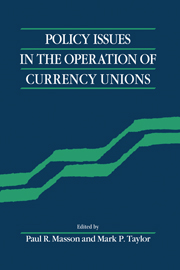Book contents
- Frontmatter
- Contents
- List of contributors
- Preface
- I Assessing the literature
- II Existing currency unions
- III Is Europe an optimum currency area?
- IV EMU: The road from Maastricht
- 8 The European System of Central Banks after Maastricht
- 9 A European money demand function
- 10 Monetary union and fiscal union: a perspective from fiscal federalism
- Index
8 - The European System of Central Banks after Maastricht
from IV - EMU: The road from Maastricht
Published online by Cambridge University Press: 04 August 2010
- Frontmatter
- Contents
- List of contributors
- Preface
- I Assessing the literature
- II Existing currency unions
- III Is Europe an optimum currency area?
- IV EMU: The road from Maastricht
- 8 The European System of Central Banks after Maastricht
- 9 A European money demand function
- 10 Monetary union and fiscal union: a perspective from fiscal federalism
- Index
Summary
Introduction
I shall start by asking in section I what new decisions about the structure and operations of the European System of Central Banks (ESCB) have emerged from Maastricht, besides the fact that previous outline drafts and proposals have now been transmuted into a signed Treaty. I identify four such innovations, of which the most important is the fixed timetable for starting stage 3 by January 1, 1999 at the latest (Article 109J, Para. 4 of the Treaty).
With the signing of the Treaty, and the protocol on the Statute of the European System of Central Banks, the objectives, structure, and governance of the ESCB have now been clearly spelt out and agreed. What still remains to be done is to work out exactly how the ESCB shall operate. This planning exercise is to be the job of the European Monetary Institute (EMI) over the next four years. Some of the issues that it will need to address on market operations, clearing and settlement, and prudential regulation are discussed in section II.
Arrangements for the EMI during stage 2, and for member states who have a derogation, i.e., they are unable to meet the convergence criteria, or unwilling in the case of the UK and Denmark to join stage 3, are set out in the Treaty and the relevant protocols. One important transitional issue has not yet been fully discussed. This concerns the move from the establishment of irrevocably fixed exchange rates (stage 3A) to a single European currency (stage 3B).
Information
- Type
- Chapter
- Information
- Policy Issues in the Operation of Currency Unions , pp. 215 - 239Publisher: Cambridge University PressPrint publication year: 1993
Accessibility standard: Unknown
Why this information is here
This section outlines the accessibility features of this content - including support for screen readers, full keyboard navigation and high-contrast display options. This may not be relevant for you.Accessibility Information
- 1
- Cited by
